1996 CHEVROLET TAHOE light
[x] Cancel search: lightPage 6 of 403

Downloaded from www.Manualslib.com manuals search engine Vehicle Symbols
These are some of the symbols you may find on your vehicle.
For example,
these symbols are used on an
original battery:
POSSIBLE A
CAUTION
INJURY
PROTECT EYES BY
SHIELDING
CAUSTIC
ACID COULD BATTERY
CAUSE
BURNS
SPARK
OR ,\I/,
COULD FLAME
EXPLODE BATTERY
These symbols
are important
for you and
your passengers
whenever your
vehicle
is
driven:
DOOR LOCK
UNLOCK
These symbols have to do with
your lights:
SIGNALS e e
TURN
WARNING
A
HAZARD
FLASHER
RUNNING
* ' 0
DAYTIME -. e
LAMPS ' **
FOG LAMPS $0
These symbols
are on some of
your controls:
WINDSHIELD
DEFROSTER
VENTILATING
a*
FAN -d
These symbols are used on
warning and
indicator lights:
COOLANT -
TEMP -
CHARGING BATTERY
SYSTEM
BRAKE
(0)
COOLANT a
ENGINE OIL w,
PRESSURE
ANTI-LOCK
(a)
BRAKES
Here are some
other symbols you may see:
FUSE
t
LIGHTER n
HORN )tr
SPEAKER
b
FUEL p3
V
Page 24 of 403
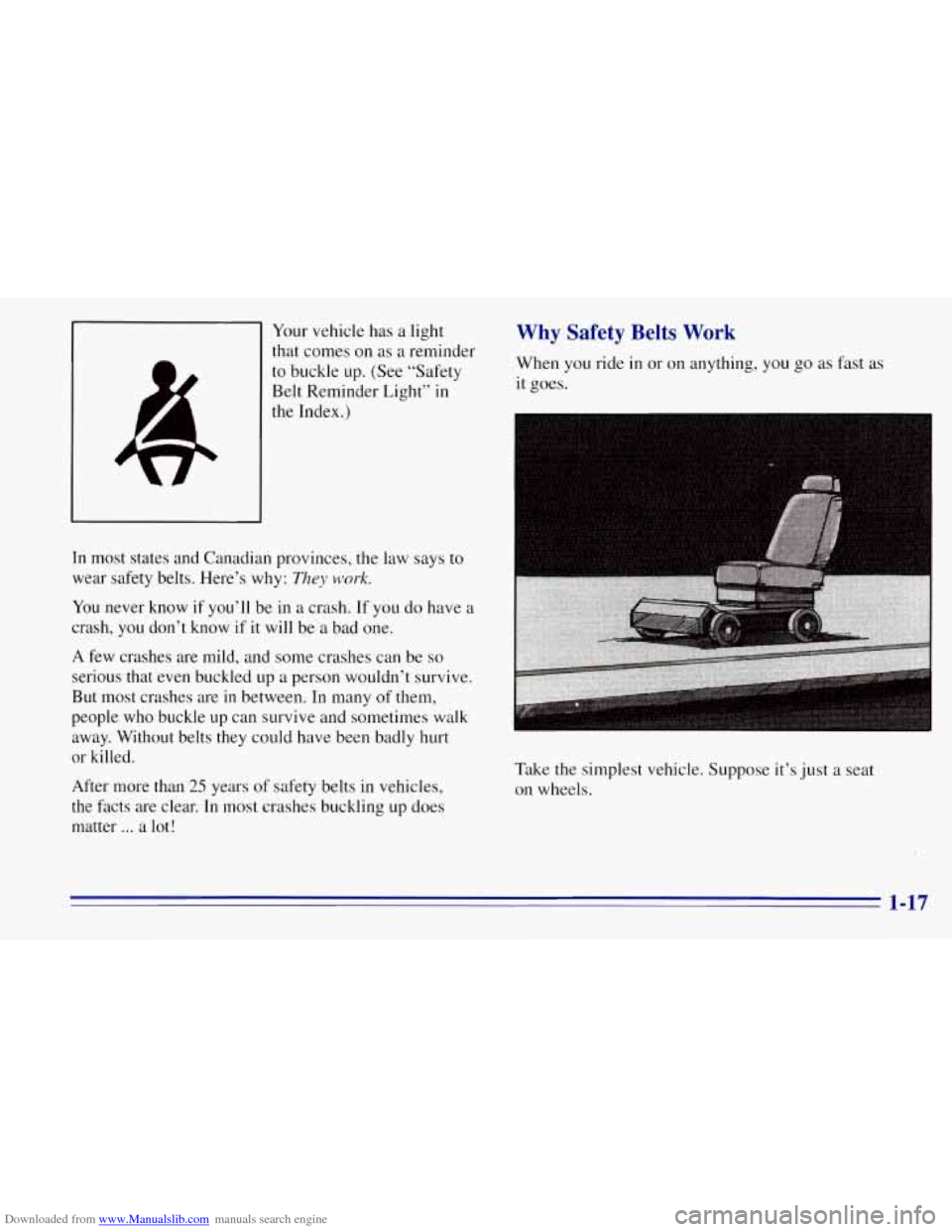
Downloaded from www.Manualslib.com manuals search engine Your vehicle has a light
that comes
on as a reminder
to buckle up. (See “Safety
Belt Reminder Light” in
the Index.)
In most states and Canadian provinces, the law says to
wear safety belts. Here’s why:
They work.
You never know if you’ll be in a crash. If you do have a
crash,
you don’t know if it will be a bad one.
A few crashes are mild, and some crashes can be so
serious that even buckled up a person wouldn’t survive.
But most crashes are
in between. In many of them,
people who buckle up can survive and sometimes walk
away. Without belts they could have been badly hurt
or killed.
After more than
25 years of safety belts in vehicles,
the facts are clear. In most crashes buckling up does
matter
... a lot!
Why Safety Belts Work
When you ride in or on anything, you go as fast as
it goes.
Take the simplest vehicle. Suppose it’s just a seat
on wheels.
1-17
Page 37 of 403
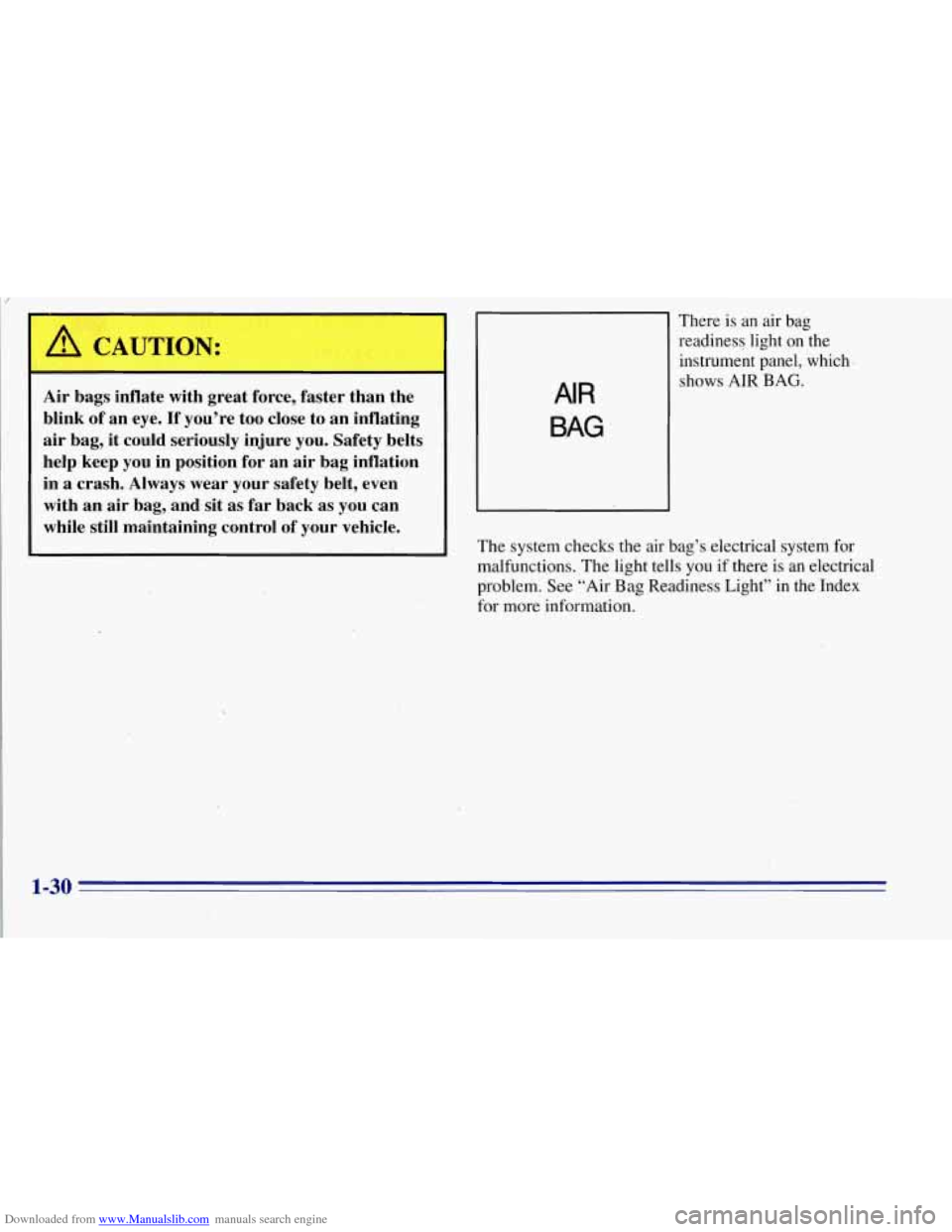
Downloaded from www.Manualslib.com manuals search engine A CAUTION:
Air bags inflate with great force, faster than the
blink of an eye.
If you’re too close to an inflating
air bag, it could seriously injure you. Safety belts
help keep you in position for an air bag inflation
in a crash. Always wear your safety belt, even
with
an air bag, and sit as far back as you can
while still maintaining control
of your vehicle.
AIR
BAG
There is an air bag
readiness light on the
instrument panel, which
shows AIR BAG.
~
I The system checks the air bag’s electrical system for
malfunctions. The light tells you
if there is an electrical
problem. See “Air Bag Readiness Light” in the Index
for more information.
1-30
Page 62 of 403
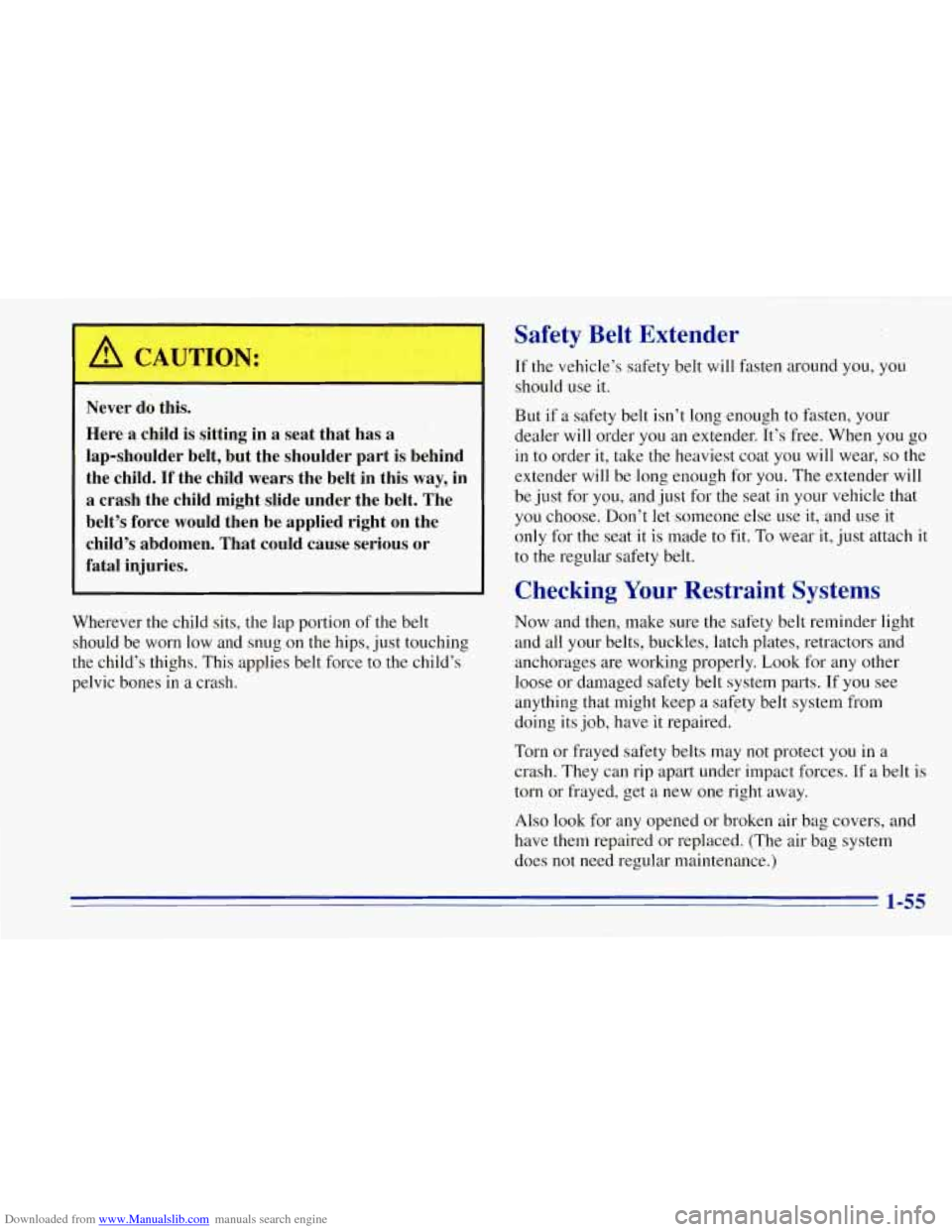
Downloaded from www.Manualslib.com manuals search engine /i CAUTION:
Safety Belt Extender
If the vehicle’s safety belt will fasten around you, you
should use it.
Never do this.
Here a child is sitting in a seat that has a
lap-shoulder belt, but the shoulder part is behind the child. If the child wears the belt in this way, in
a crash the child might slide under the belt. The
belt’s force would then be applied right on the child’s abdomen. That could cause serious or
fatal injuries. ~ But if a safety belt isn’t long enough to fasten, your
’ dealer will order you an extender. It’s free. When you go
in
to order it, take the heaviest coat you will wear, so the
extender will be long enough for you. The extender will
be just for you, and just for the seat
in your vehicle that
you choose. Don’t let someone else use
it, and use it
only for the seat it is made to fit. To wear it, just attach it
to the regular safety belt.
I I Checking Your Restraint Systems
Wherever the child sits, the lap portion of the belt Now
and then, make sure the safety belt reminder light
should be worn low and snug on the hips, just touching and all your belts, buckles, latch plates, retractors and
the child’s thighs. This applies belt force
to the child’s anchorages
are working properly. Look for any other
pelvic bones in a crash. loose or damaged safety belt system parts. If you see
anything that might keep a safety belt system from
doing its job, have it repaired.
Torn or frayed safety belts may not protect
you in a
crash. They can rip apart under impact forces. If a belt is
torn or frayed, get a new one right away.
Also look for any opened or broken air bag covers, and
have them repaired or replaced. (The air bag system
does not need regular maintenance.)
1-55
Page 72 of 403
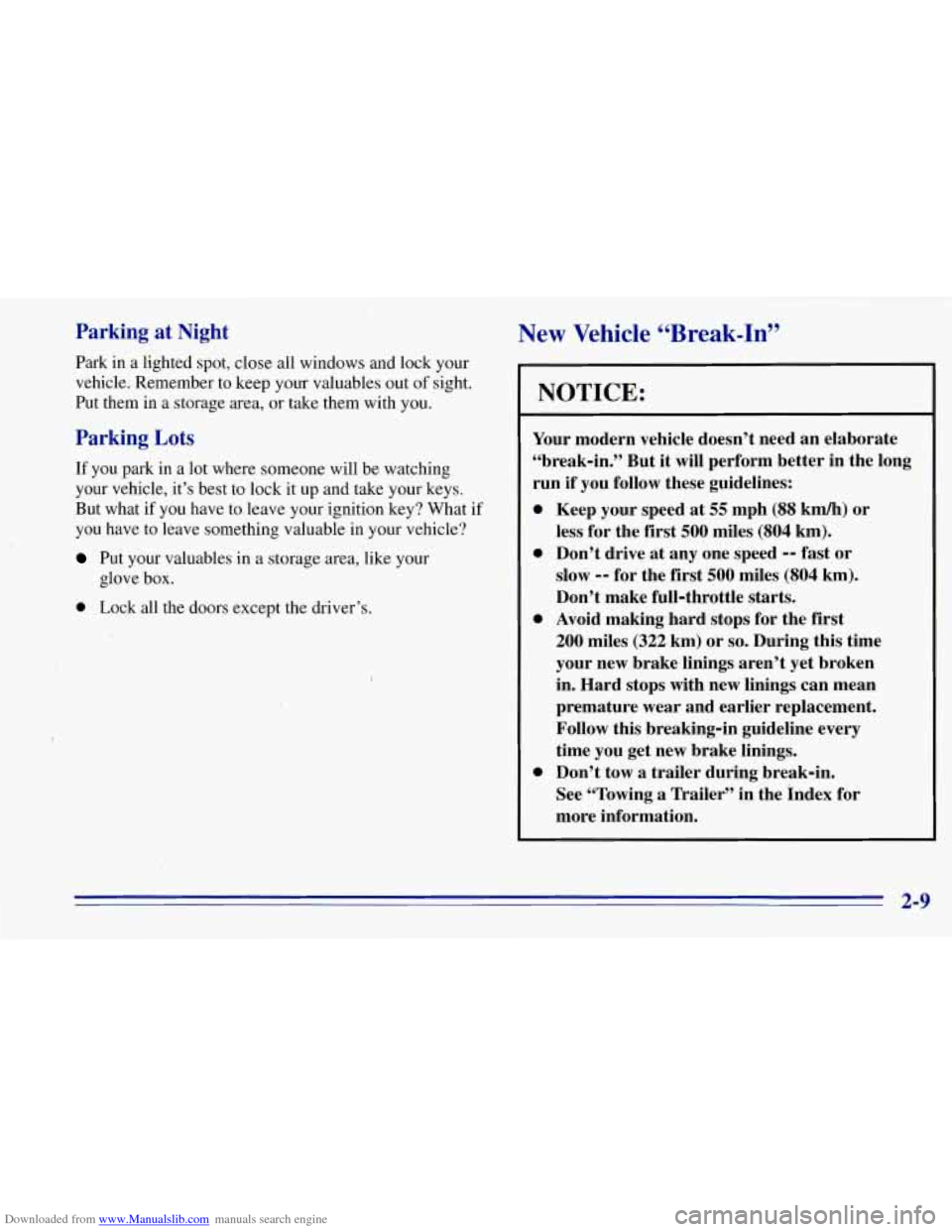
Downloaded from www.Manualslib.com manuals search engine Parking at Night
Park in a lighted spot, close all windows and lock your
vehicle. Remember to keep
your valuables out of sight.
Put them in a storage area,
or take them with you.
Parking Lots
If you park in a lot where someone will be watching
your vehicle, it’s best
to lock it up and take your keys.
But what
if you have to leave your ignition key? What if
you have to leave something valuable in your vehicle?
Put your valuables in a storage area, like your
0 Lock all the doors except the driver’s.
glove box.
New Vehicle “Break-In”
NOTICE:
Your
modern vehicle doesn’t need an elaborate
“break-in.” But it wil1,perform better in the long
run
if you follow these guidelines:
0
0
0
0
Keep your speed at 55 mph (88 kmh) or
less for the first
500 miles (804 km).
Don’t drive at any one speed 0- fast or
slow
-- for the first 500 miles (804 km).
Don’t make full-throttle starts.
Avoid making hard stops for the
first
200 miles (322-km) or so. During this time
your new brake linings aren’t yet broken
in. Hard stops with new linings can mean
premature wear and earlier replacement.
Follow this breaking-in guideline every
time you get new brake linings.
Don’t tow a trailer during break-in.
See “Towing a Trailer” in the Index for
more information.
2-9
Page 80 of 403
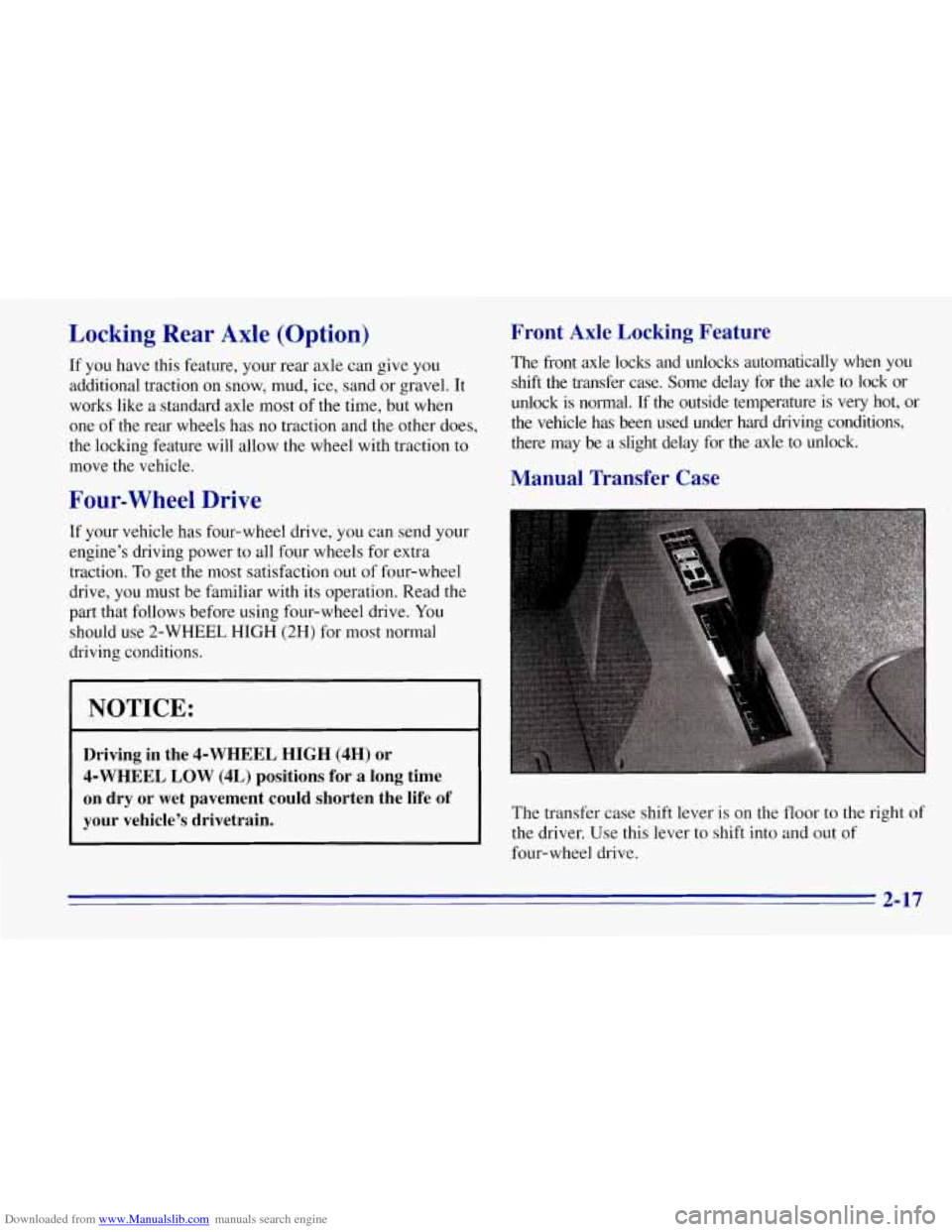
Downloaded from www.Manualslib.com manuals search engine Locking Rear Axle (Option)
If you have this feature, your rear axle can give you
additional traction on snow, mud, ice, sand or gravel. It
works like a standard axle most of the time, but when
one of the rear wheels has no traction and the other does,
the locking feature will allow the wheel with traction to
move the vehicle.
Four-wheel Drive
If your vehicle has four-wheel drive, you can send your
engine’s driving power
to all four wheels for extra
traction.
To get the most satisfaction out of four-wheel
drive, you must be familiar with its operation. Read the
part that follows before using four-wheel drive. You
should use 2-WHEEL HIGH (2H) for most normal
driving conditions.
NOTICE:
Driving in the 4-WHEEL HIGH (4H) or
$-WHEEL LOW (4L) positions for a long time
on dry or wet pavement could shorten the life
of
your vehicle’s drivetrain.
Front Axle Locking Feature
The front axle locks and unlocks automatically when you
shift the transfer case. Some delay for the axle to lock or
unlock is normal. If the outside temperature is very hot, or
the vehicle has been used under hard driving conditions, there may be a slight delay for the axle
to unlock.
Manual Transfer Case
The transfer case shift lever is on the floor to the right of
the driver. Use this lever to shift into and out of
four-wheel drive.
2-17
Page 81 of 403
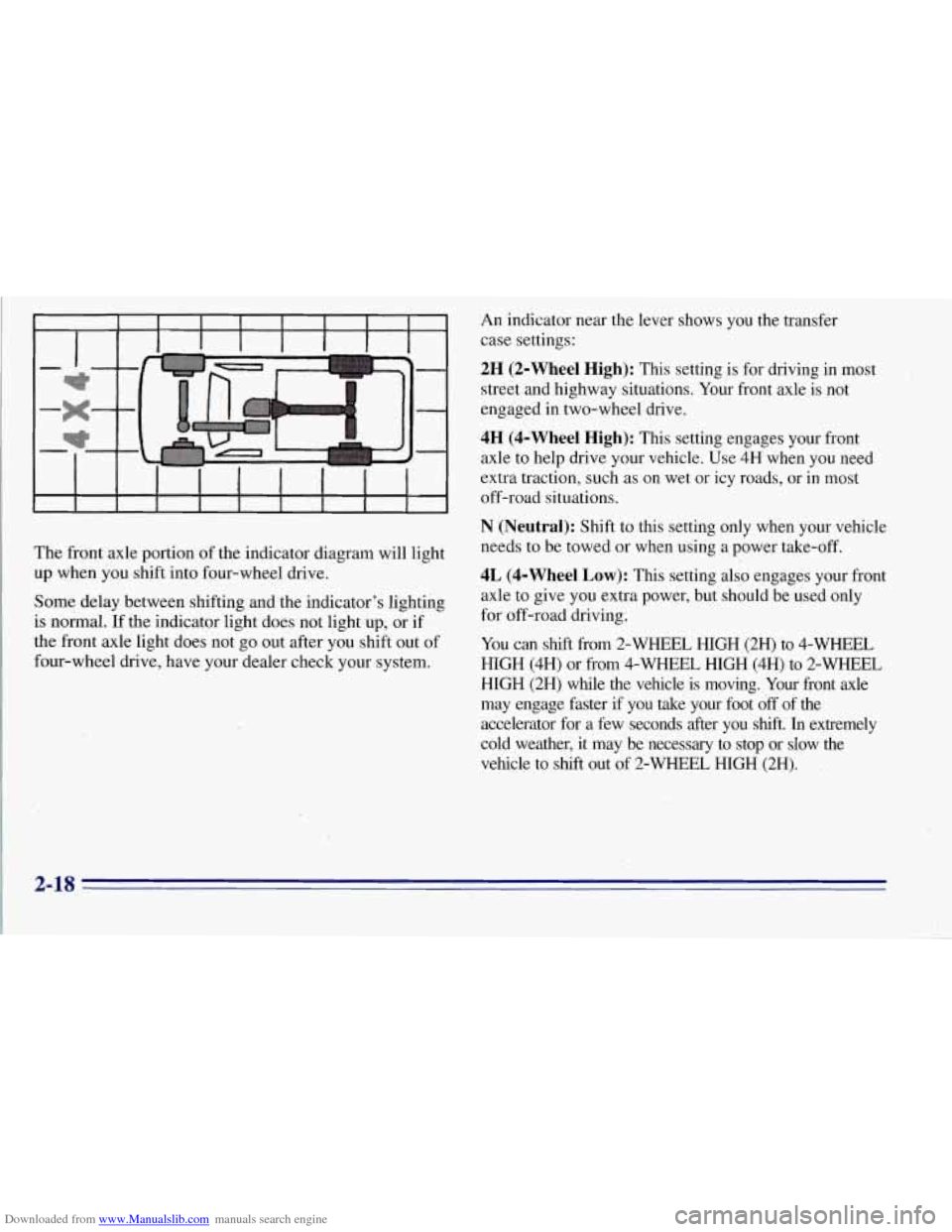
Downloaded from www.Manualslib.com manuals search engine The front axle portion of the indicator diagram will light
up when you shift into four-wheel drive.
Some delay between shifting and the indicator's lighting
is normal. If the indicator light does not light up, or if
the front axle light does not go out after you shift out of
four-wheel drive, have your dealer check your system.
An indicator near the lever shows you the transfer
case settings:
2H (2-Wheel High): This setting is for driving in most
street and highway situations. Your front axle is not
engaged in two-wheel drive.
4H (4-Wheel High): This setting engages your front
axle
to help drive your vehicle. Use 4H when you need
extra traction, such as on wet
or icy roads, or in most
off-road situations.
N '(Neutral): Shift to this setting only when your vehicle
needs to be towed or when using a power take-off.
4L (4-Wheel Low): This setting also engages your front
axle to give you extra power, but should be used- only
for off-road driving.
You can shift from 2-WHEEL HIGH (2H) to 4-WHEEL
HIGH (4H) or from 4-WHEEL HIGH (4H) to 2-WHEEL
HIGH
(2H) while the vehicle is moving. Your front axle
may engage faster if you take
your foot off of the
accelerator for a few seconds after you shift.
In extremely
cold weather, it may be necessary to stop or slow the
vehicle to
shift out of 2-WHEEL HIGH (2H). .
,
2-18
Page 82 of 403
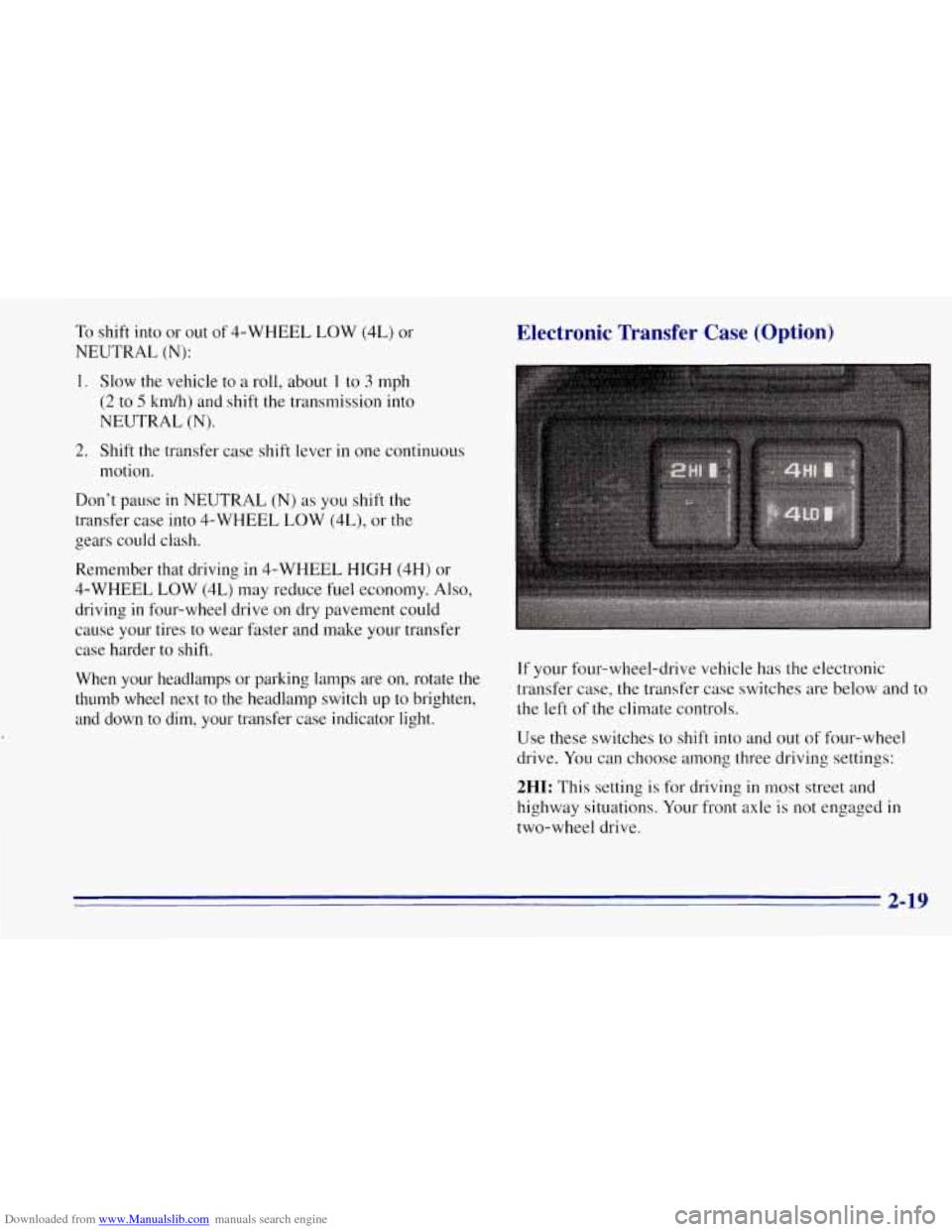
Downloaded from www.Manualslib.com manuals search engine To shift into or out of 4-WHEEL LOW (4L) or
NEUTRAL (N):
1. Slow the vehicle to a roll, about 1 to 3 mph
(2 to 5 km/h) and shift the transmission into
NEUTRAL (N).
2. Shift the transfer case shift lever in one continuous
motion.
Don’t pause
in NEUTRAL (N) as you shift the
transfer case into 4-WHEEL LOW (4L), or the
gears could clash.
Remember that driving
in 4-WHEEL HIGH (4H) or
4-WHEEL LOW (4L) may reduce fuel economy. Also,
driving
in four-wheel drive on dry pavement could
cause your tires
to wear faster and make your transfer
case harder to shift.
When your headlamps or parking lamps are on, rotate the
thumb wheel next to the headlamp switch up to brighten,
and down to dim, your transfer case indicator light.
Electronic Transfer Case (Option)
If your four-wheel-drive vehicle has the electronic
transfer case, the transfer case switches are below and to
the left of the climate controls.
Use these switches to shift into and out of four-wheel
drive.
You can choose among three driving settings:
2HI: This setting is for driving in most street and
highway situations. Your front axle is not engaged
in
two-wheel drive.
2-19